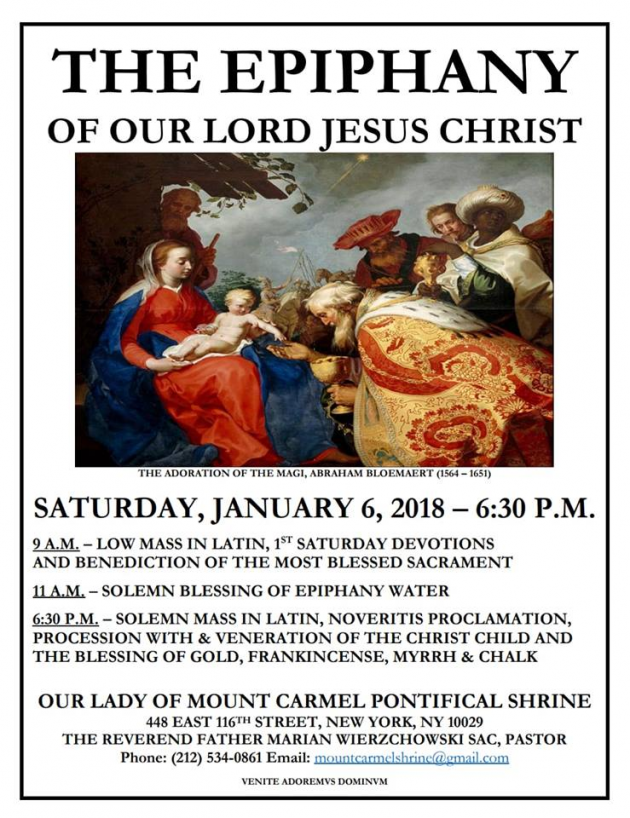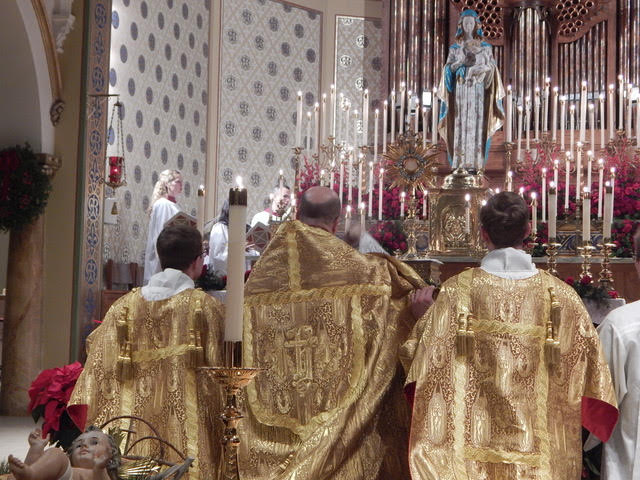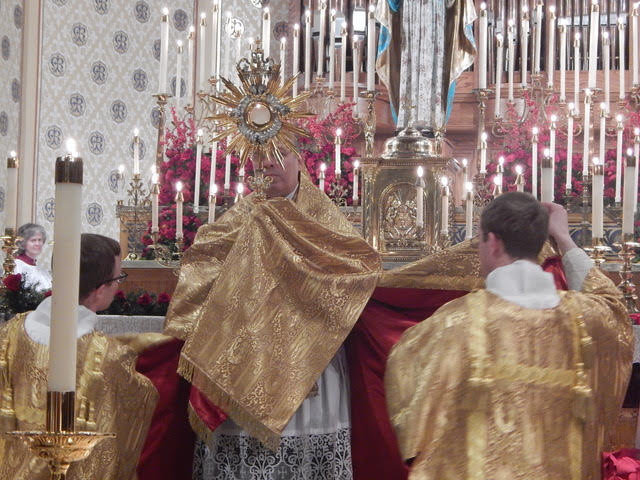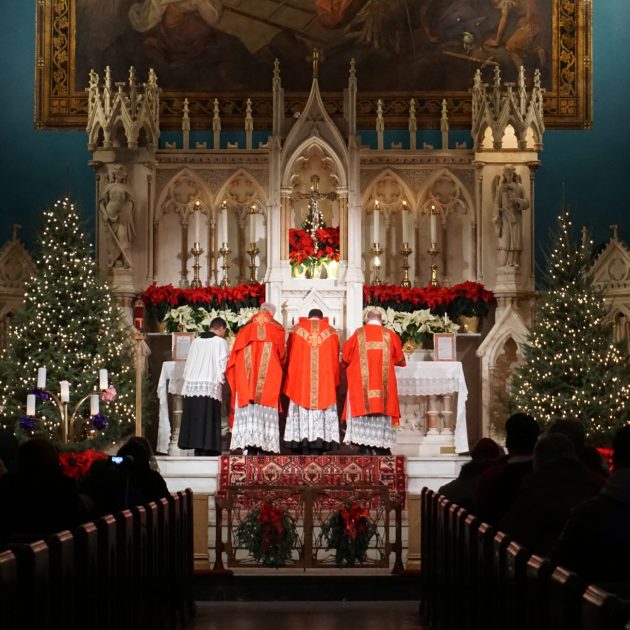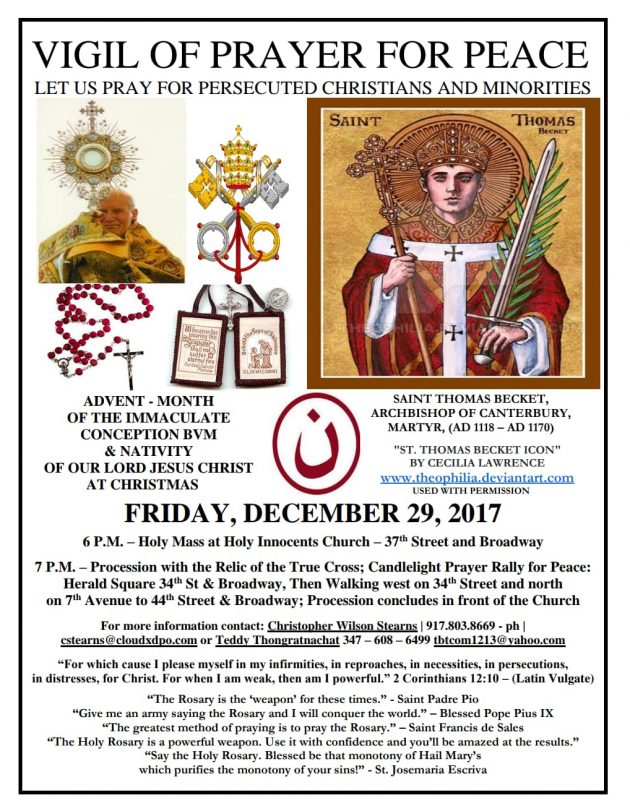Monday, January 22,2018 Feast of Saint Vincent Pallotti and also the 18th Anniversary of Father Christopher Salvatori’s ordination to the priesthood.
11
Jan
Happy Epiphany!
Posted by Stuart ChessmanCOMPARE AND CONTRAST:
The birth, as told in the Gospel of Luke, was heralded by an angel, whose words to the shepherds of Bethlehem were, “Be not afraid, for I bring you tidings of great joy.” The Gospel of Matthew tells us of the three wise men from the East who, guided by a star, visited the babe bearing gifts of gold, frankincense and myrrh. This is the story of Christmas that we, as Christians, need to tell. We need to be sure that our children know it, that it’s emphasized in religious education classes—and in our homes.
(….)
As for the four biblical stories outlined above, Catholics generally had a high level of belief, but there too, the numbers are trending downward. In 2017, 83 percent said they believe in the virgin birth (86 percent in 2014), 82 percent said an angel announced Jesus’ birth to shepherds (90 percent), 80 percent said wise men guided by a star brought Jesus gifts (84 percent), and 87 percent said Jesus was laid in a manger (92 percent). In 2014, 76 percent said they believed all four elements happened; in 2017, 71 percent said that. While those numbers are not dramatically poor, the survey found that millennials, including Christian millennials, are less likely than older respondents to believe all four biblical stories. We don’t want to wring our hands over these numbers, but we do want to open our eyes and try to halt or even reverse the slide. The Christmas story, after all, is the start of what has been called The Greatest Story Ever Told.
Don’t Gloss over the Christmas Story (Editorial, Catholic New York 12/21/2017)
This weekend we celebrate the feast of the Epiphany on which we hear the familiar story of the
Magi, those ancient astronomers who follow a divine GPS to discover the One they are searching
for. Although scripture scholars remind us that this is not a historical event but rather an infancy
narrative pregnant with theological and scriptural meaning, the journey of the Magi has captured
the imagination of artists through the centuries. It is also timely in our own age when there are
so many people who are refugees and immigrants, people fleeing from poverty and the ravages
of war.
From the Pastor’s Desk, (Fr. Bob VerEecke S.J, 1/7/2018 Bulletin of St Francis Xavier parish, New York)
Fr VerEecke does not occupy at all some kind of “fringe” position in the New York Archdiocese. On the contrary, the very same Catholic New York reports favorably on the performance of his dance production at the Sheen center in 2016 and 2017. (The Jesuit head of America Media sits on the board of the Sheen center)
10
Jan
There will be an extraordinary form votive Mass of the Holy Cross on Friday, January 19th at 7:30 PM at St. Mary’s Church in Greenwich, CT
8
Jan
A Traditional Latin Missa cantata will be offered at the Church of Saint Agnes, 143 East 43rd Street, Manhattan
(near Grand Central Terminal), on Saturday, January 13 at 10:30 AM, for the commemoration of the Baptism of Our Lord.
Father Tomasz Szczepanczyk, Celebrant
Music provided by Mr. Heitor Caballero, Director of Sacred Music
Wood relief, part of the high altar of St. Michael’s Church, Niederrotweil, Germany
7
Jan
Those damned Traditionalists!
Posted by Stuart Chessman(Above)The sanctuary of the Church of St Martha, Enfield. The Hartford Courant explains : “An altar rail is a hallmark of St. Martha church and is used by parishioners to receive communion during Latin Mass.” Photo by John Woike | jwoike@courant.com (John Woike / Hartford Courant)
We have rejoiced in the continued vitality of the Catholic Traditionalist movement, particularly in this corner of the world. That should not blind us, however, to the depth of the opposition that remains extremely active within the Church establishment. We have heard of recent incidents and indeed have experienced others ourselves – emanating primarily from the clergy but also from the “churchy” element of the laity who have absorbed the progressive clergy’s view of the world over the decades. A noteworthy recent published example comes to us from the Archdiocese of Hartford.
St. Martha is a parish in Enfield ( a town the northern part of the state of Connecticut), which, as you know if you have been following our listings of announced Holy Day masses, regularly offers the traditional liturgy. Not too long ago it was merged with two other parishes in the course of the Archdiocese of Hartford’s current course of drastic downsizing. Now that merger has been undone. The cause? Although there seem to be other issues for the split, including control of the school, the discussion focuses on the fact that St. Martha’s celebrates the traditional mass. This was unacceptable to the congregations of the other two merged parishes .
“Clash of culture leads to failed Parish Merger in Enfield” Article in the Hartford Courant (November 19, 2017)by Jordan Otero Sisson.
“Parishioners and archdiocesan leaders agreed that a difference in culture was a major point of contention when the parishes were merged. St. Martha is a more traditional church, while St. Patrick and St. Adalbert, considered more contemporary, with strong social justice ministries and outreach efforts, and that clash caused some tensions, they said.”
Walter Wojciehowski, the former parish council president at St. Adalbert, and Tim Fiore, the former St. Patrick parish council president, said … many parishioners felt as though the culture of St. Martha was transplanted to the new parish without consultation of the other communities, creating what Wojciehowski described as a “toxic atmosphere.”
The Courant adds: “One of the main points of contention was where the new parish would offer a traditional Latin Mass, which had been celebrated at St. Martha.” For the traditional mass was now proposed to be celebrated in St Adalbert – the more “traditional” venue among the three churches of the merged parish, at least in terms of architecture.
The Hartford Courant reporter then helpfully explains some differences between the Traditional Mass and the “Norvus Ordo” (sic) (His explanation is actually quite fair.)
The opposition of the leaders of the two other parishes to the traditional mass was militant:
“This was a case of the church having moved beyond this in the ’60s, so why are we going back and why are you dragging us back?” Fiore asked. “We have no interest in going back. We were afraid the whole Latin Mass culture would seep its way into the modern Mass church.”
The solution of the Archdiocese? Aside from the usual response (blaming the laity), it has undone the merger, at least for the time being. Not a word is uttered against the outrageous statements against Catholic traditionalism set forth in the above article. And why should there be? The Archdiocese of Hartford emerged early on as a progressive leader; it is now reaping the fruits of decades of progressive dysfunction.
As the parish leader of St Adalbert puts it, employing media buzzwords:
“I think there is enough room for all, but the main issue here has to be to be inclusive and to respect the feelings and the culture of the other parties involved,” he said. “If that doesn’t happen … I don’t see how that could be successful.” (After he himself has showed no respect for the “culture of St Martha.”)
3
Jan
(From Notre Dame Cathedral, Chartres)
The following churches will offer the Traditional Mass for the Feast of Epiphany on Saturday, January 6.
St. Mary Church, Norwalk, CT, Solemn High Mass, 9 am.
Sts. Cyril and Methodius Oratory, Bridgeport, CT
Solemn High Mass, 9:00 am. On the Eve of the Epiphany, January 5th, there will be the blessing of the Epiphany Water after the evening Mass. In addition to the water blessing, chalk and incense will be blessed. If you have incense or chalk which you would like to be blessed, please bring it before Mass.
St. Martha Church, Enfield, CT, 9 am.
Church of the Holy Innocents, New York
Epiphany Water and chalk will be blessed following the 6:00 p.m. Mass on FRIDAY, JANUARY 5. All-night vigil of prayer and reparation will take place this Friday, January 5 beginning at 8:00 p.m. with exposition of the Most Blessed Sacrament and the praying of Vespers and Compline at 9:00 p.m. The night of prayer will conclude on Saturday, January 6 with a Eucharistic Procession at 4:30 a.m. and the celebration of a Low Latin Tridentine Mass at 5:00 a.m. A Missa Cantata will be offered on Jan. 6 at 1 pm.
Pontifical Shrine of Our Lady of Mount Carmel, New York, Low Mass, 9 am; Solemn Mass, 6:30, procession with the Christ Child and blessing of gold, frankincense, myrhh and chalk.
St. Anthony of Padua Oratory, West Orange, NJ, 9 am.
Our Lady of Fatima Chapel, Pequannock, NJ, 9 am
2
Jan
New Year’s Eve Te Deum
Posted by Stuart ChessmanOn New Year’s Eve, St. Mary’s Church in Greenwich had Benediction of the Most Blessed Sacrament and the singing of the Te Deum. Photos courtesy of Fr. Cyprian La Pastina.
1
Jan
The Dictator Pope
Posted by Stuart ChessmanThe Dictator Pope
By “Marcantonio Colonna”
The Dictator Pope hit our Kindles (it’s not yet in hard copy) just in time for Christmas. I can tell you, after a quick read, that it’s the best Vatican expose since 1999’s Gone with the Wind in the Vatican by “I Millenari” (indeed, some of the targets in the curia seem to be the same in both these works). But the focus of the Dictator Pope greatly differs from that work. It concentrates not so much on inside “revelations” but on the career, background and circumstances on one individual – namely, Pope Francis. It seeks to deepen our understanding of what is already known, to provide background and to “connect the dots” among people and policies.
The Dictator Pope is streamlined, succinct and well written. Here and there (such as in his discussion of the situation of the Knights of Malta) our author – “Marcantonio Colonna” – does seem to display specific knowledge beyond what has been published previously. Yet, as I noted, this book does not emphasize journalistic “leaks.” We indeed are told Pope Francis directed the contribution of funds to the presidential campaign of Hillary Clinton. But does that supposed fact have any significance given what we already know about the media support, both direct and indirect, given to the Democratic Party by Francis – surely of incomparably greater value to Hillary than any money Francis could put on the table?
For several reasons the Dictator Pope strikes me as reliable. For one thing, Colonna’s description of Jorge Bergoglio’s style and modus operandi agrees very well with what I have been told by those with more direct knowledge than I possess of his doings in both Rome and Argentina. It also corresponds to certain reports that have appeared now and then in the European – never the English language – mainstream press. Curiously, some of these unflattering accounts are found in sources – like the German media – otherwise entirely aligned with Bergoglio.
Marcantonio Colonna shows the stuff of a true historian in creating a narrative of the Bergoglio years and offering his judgment on what he describes. Instead of nonsense about “God’s choice,” the colorful account of the Dictator Pope has the ring of truth: the relentless rise to the top of an ambitious and manipulative man, the making of strategic alliances and political concessions leading to the acquisition of the papacy and the imposition of the Pope’s personal agenda, the ruthless elimination of real or imaginary enemies, the advancement of unworthy and corrupt favorites. The Vatican as described in this work reminds us of the stories of the Renaissance papacy told in the great histories of Leopold von Ranke and Ludwig von Pastor. Indeed, Marcantonio Colonna himself draws comparisons between Pope Francis and certain ruthlessly ambitious, often megalomaniac and, in one or two cases, perhaps even insane popes of the 14th – 17th centuries, as so well described by his illustrious predecessors.
This portrait of Pope Francis outlined in the Dictator Pope, though, requires some qualification. For one thing, the popes of the past to whom Colonna compares Francis may have been lacking in one or more – or many – of the Christian virtues ( and often in sound judgment as well ) but they were strong characters who battled against and among other powerful rival families and factions within the Church and with the great secular kingdoms and principalities of their day. Francis only has to contend with the bureaucratic ninnies of the post – Vatican II Catholic hierarchy. Regarding today’s secular powers – like the news media – Francis pursues a policy of obsequious and abject submission. For, without exception, the policies of Francis are those of the Western secular establishment from whose support Francis derives all his power.
Furthermore, these notorious popes of the past showed rare taste in art and culture. I don’t know what the reign of Francis has to offer in comparison – a homoerotic nativity scene or one of Cardinal Ravasi’s exhibits? And whatever else they were doing, the popes of the Renaissance also devoted great personal attention to the liturgy – the celebration of the papal ceremonial was a major attraction of that period. Pope Francis either disregards the liturgy altogether or “repurposes” it for political statements.
I also must take issue with Colonna’s unduly restrictive characterization of significance of the papacy of Francis. For if Francis were simply one more unscrupulous, ambitious and opportunistic prelate – like Alexander VI – we could consider him simply a regrettable but ultimately remediable failure of the papal election process. But the added dimension of Francis’s papacy is his clear ideological commitment to Catholic progressivism. Whether that is simply a cynical means to the acquisition of power (as Colonna implies) or is a matter of personal conviction is irrelevant – it is by now an unalterable aspect of his character. Whatever the origin of his beliefs may be, Pope Francis is a man with a mission to “unleash” and “make irreversible” the Vatican II – to make permanent what has been done since 1962-65 and to implement further radical changes in Catholic liturgy, morality and theology. And the policies of Pope Francis are not a bolt from the blue, but the logical culmination of the disastrous trends in theology, morality, liturgy and government in the Catholic Church that have been allowed to develop and fester since 1962-65. Pope Francis’s progressive agenda involves not just the completion of a revolution within the Church but the final, absolute subjection of the Church to the dominant secular powers of 21st century.
Marcantonio Colonna’s narrative helps us to see the current situation in the Church more clearly. And a clear view of what’s going on is always a major first step forward towards reform. The response of the Vatican to this book, we hear, is a search for the author’s identity. For the rest of us, Dictator Pope is a challenge: to reflect, to pray and to take action.
30
Dec
Feast of the Holy Innocents
Posted by Stuart ChessmanSolemn Mass for the Feast of the Holy Innocents at Holy Innocents Church, New York on December 28. Photo courtesy of Diana Yuan.
28
Dec
Contact us
Register
- Registration is easy: send an e-mail to contact@sthughofcluny.org.
In addition to your e-mail address, you
may include your mailing addresss
and telephone number. We will add you
to the Society's contact list.
Search
Categories
- 2011 Conference on Summorum Pontifcum (5)
- Book Reviews (95)
- Catholic Traditionalism in the United States (24)
- Chartres pIlgrimage (17)
- Essays (176)
- Events (670)
- Film Review (7)
- Making all Things New (44)
- Martin Mosebach (34)
- Masses (1,343)
- Mr. Screwtape (46)
- Obituaries (15)
- On the Trail of the Holy Roman Empire (22)
- Photos (347)
- Pilgrimage Summorum Pontificum 2021 (7)
- Pilgrimage Summorum Pontificum 2022 (6)
- Pilgrimage Summorum Pontificum 2023 (4)
- Sermons (79)
- St. Mary's Holy Week 2019 (10)
- St. Mary's Holy Week 2022 (7)
- St. Mary's Holy Week 2023 (7)
- St. Mary's Holy Week 2024 (6)
- Summorum Pontificum Pilgrimage 2024 (2)
- Summorum Pontificum Pilgrimage 2025 (7)
- The Churches of New York (198)
- Traditionis Custodes (49)
- Uncategorized (1,375)
- Website Highlights (15)
Churches of New York
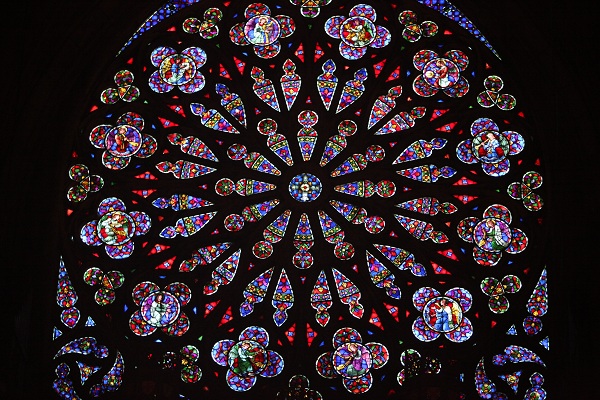
Holy Roman Empire

Website Highlights
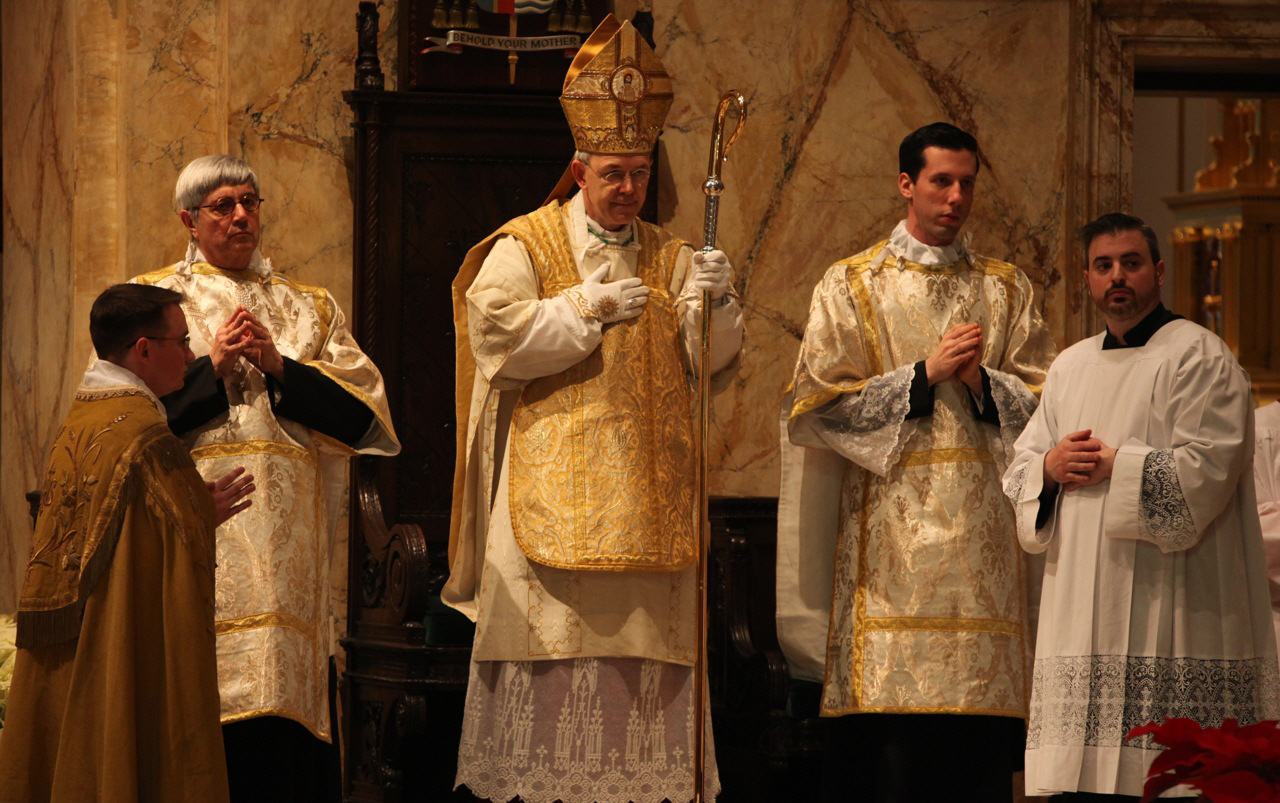
Archives

[powr-hit-counter label="2775648"]





